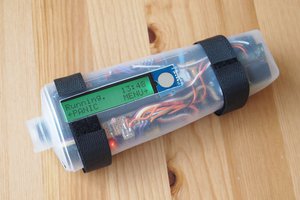Point of this devices existence is to have a nice thermometer with some extended functions. Here are some parameters/ facts about the project/ device:
-Hardware is created using Altium Designer
-Software is written in C language using Atmel Studio tool
-The heart of the device is Atmega32u4
-User interface consists 16x2 LCD display (HD44780 driver), 3 tact switches and 3 user LEDs
-The device logs temperature from last 24 hours (measured every 10 minutes). It downloads the time and date from DS1307 (via I2C) that is powered up with 3V cell battery when there is no power
-Temperature is measured using DS18B20 connected via 1-Wire. Board is ready for soldering SMD version and has a socket for connecting a device on a cable
-The main screen consists current date/ time and temperature
-Pressing middle button will show the highest and lowest temp from the last 24h
-Pressing left/right button will cycle through the temperature logs gathered
-Data is displayed on the screen using multiplexing
-Device can be connected to the PC via USB. The connection simulates a serial port. On the PC there is an app written in C# that allows user to set various parameters like date/time for the DS1307 or read the actual temperature. I plan to extend this application for logging way more data.
Here I have linked a video showing how does the device work (some early stage, didn’t use celcius sign yet lol). I will post more videos as soon as I solder-up the actual board. Keep in mind that logged data is held in SRAM which means it needs at least 24h to fill every “register”.
About the software:
I havent written everything from scratch- I have found some usefull libraries over the internet like the ones from Mr. Camera who I really admire for creating LUFA library and his commitment for AvrFreaks forums (http://fourwalledcubicle.com/AboutMe.php) or Mr. Kardas (Blogger, programmer and book writer from my town). Thanks to their libsi could launch up this project really fast and its easily extendable. I obviously added some mad alghoritms of my own :>.
The PC app is written by mysalfe and for now it covers only basic functions but i want to extend it to a full temp logger with characteristics drawing etc.
About the Hardware:
The board may seem to big but there is a reason for all this free space on the board:
LCD panel is pretty big and is stuck not so high in the same time. That means i couldnt really put anything else than SMD devices under it. All the connectors, buttons and LEDS had to be placed next to it.
 Łukasz Przeniosło
Łukasz Przeniosło



 andriy.malyshenko
andriy.malyshenko
 WJCarpenter
WJCarpenter

 Andrey Ovcharov
Andrey Ovcharov